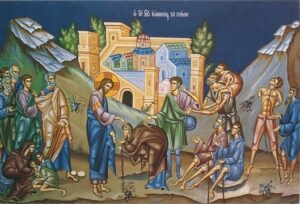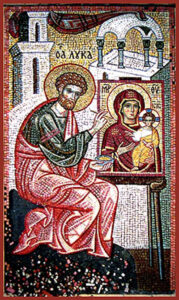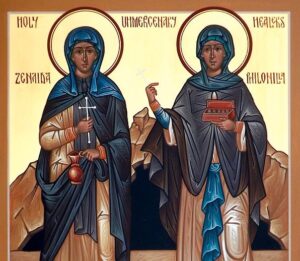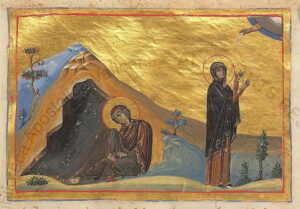
Actually our Lord and Savior Jesus Christ founded Christian medical practice, as He went from place to place healing peoples’ bodies and souls.
However, today we’re going to look at four mere human beings who followed in His footsteps and built on what He had begun. What brought this to my mind was the fact that in the Church’s calendar three of them were commemorated in mid-October.
1) Saint Luke, the Beloved Physician
He is commemorated on October 18 by Eastern Orthodox, Roman Catholics, Anglicans, and Lutherans, and by the Coptic Orthodox on November 1.
We know Luke’s profession because Saint Paul wrote in his letter to the Colossians: “Luke the beloved physician and Demas greet you.” Colossians 3:14

We know, of course, of Saint Luke’s work as a skilled historian and writer from his books The Gospel according to Saint Luke and The Acts of the Apostles. Tradition tells us that he was also an artist, a painter, the Church’s first iconographer, believed to have “written” icons of the Virgin Mary, of which several (or very early copies thereof) are still in existence. We know that Luke sometimes traveled with Saint Paul on his missionary journeys: Note the passages in his Book of Acts which occasionally switch from third person plural (“they”) to first person plural (“we”) – Acts 16:10-17; 20:5-21:18; 27:1–28:16. According to the most common Tradition *, Luke was the man who, walking with Cleopas on the Road to Emmaus, encountered the Risen Lord on Pascha night.
- Saint John Chrysostom and some others disagreed.
However, as far as his work as a physician, even the Church’s Tradition tells us very little. I searched, but could find no icons of “Saint Luke the Physician”.
We do know from Saint Paul that people loved him. He was “a good doctor”.
We know he was a Greek from Antioch of Syria, then the Great City of the East. It has been noted that when he was with Saint Paul on the island of Malta, Luke gave a very specific medical diagnosis: “And it happened that the father of Publius lay sick of a fever and dysentery. Paul went in to him and prayed, and he laid his hands on him and healed him.” Acts 28:8
That’s what we know about Luke personally.
However, we also know that Greek physicians were trained in what we now call (and are recovering after all these centuries) “holistic medicine”, using the inter-relationships of soul, mind and body to accomplish healing. *
- “The Cartesian division of body and soul, man and nature, conscious and unconscious was absent from the logic of ancient medicine.” (Dr Spiros Despotis, in The Apostle Luke as Physician and Healer, quoted in Mystagogy. See below.)

We know that Greek physicians were bound by the Hippocratic Oath * whereby they pledged to prescribe only beneficial treatments, to refrain from causing harm or hurt. Here is a portion of the Oath: “With regard to healing the sick, I will devise and order for them the best diet, according to my judgment and means; and I will take care that they suffer no hurt or damage. Nor shall any man’s entreaty prevail upon me to administer poison to anyone; neither will I counsel any man to do so. Moreover, I will give no sort of medicine to any pregnant woman, with a view to destroy the child. Further, I will comport myself and use my knowledge in a godly manner.”
- Today, physicians abide by any one of a number of revised versions of the Hippocratic Oath.
And that’s all we can surmise about Saint Luke the Beloved Physician.
2) Zenais (or Zenaida) and Philonella

These are two of the three little noticed * apostolic women who set the standards for Christian medical practice. We know about them through the Church’s earliest Tradition.
- At least I had never noticed them till October 11 this year, when I read about them in John Sadinopoulos’ excellent Blog which you really should follow daily: https://www.mystagogyresourcecenter.com/
They were the first of those whom the Church titles “Holy Unmercenaries” [Άγιοι Ανάργυροι], physicians who treated the sick without taking money for it.
At about the same time that Saint Luke lived, these two sisters went much further in laying the groundwork for Orthodox Christian medical ethics and practice. They are commemorated on October 11 among Eastern Orthodox and on April 14 by some Anglicans – and nowhere else, so far as I can discover.

Saints Zenais and Philonella were from a notable Jewish family of Tarsus, and cousins of Saint Paul the Apostle and Jason *, first Bishop of the church in Tarsus – the man who took Paul and his company into his home and got into considerable trouble with the populace because of it. (Read Acts 17:5-10.) Through these connections, the sisters became among the earliest believers in Jesus Christ and the Christian Faith.
Who says women were always confined to the home in Apostolic times? At least Philonella and Zenais were not. Because of their intelligence they were educated at the great learning centers in Tarsus, specializing (“majoring”, as we might say) in philosophy and medicine. After they came to know Christ and His love, it was natural and easy for them to try to integrate classic Greek medicine with Christian understanding of the goodness of creation, and the love and compassion of Christ for people, mind, soul and body, and their salvation. After finishing their studies, Saints Zenais and Philonella moved to Thessaly in Greece, where many medicinal mineral springs were found in the caverns of the Pelion Mountains. They settled there in a cave and built a small Christian chapel. The many pagan physicians who also practiced there, in the service of the Greek god Asclepios and goddess Panacaea, were distressed to find great crowds coming to visit these women who worshiped a “foreign” God. They were especially distressed to find the sisters not charging their patients, since despite their Hippocratic Oath many of the pagan physicians were finding the healing business quite lucrative financially.
Saint Philonella approached healing by studying it in a Christian scientific way, freeing it from magic, astrology and other superstitions.
Saint Zenais concentrated more on the compassionate side of Christian healing. She cared deeply about children and their suffering and developed Christian pediatric care for the first time. She also became a “spiritual mother” for both men and women. In fact three of her male spiritual children built a small men’s monastery (as we would now call it) in order to stay and work near her.
Because many of the people who came to Saint Zenais suffered from what we would now call psychiatric disorders – depression, anxiety and the like – it is said that late in life, she became interested in psychiatric medicine. By prayer, counseling and medicine she freed them from their debilitating illnesses, just as her Lord Jesus Christ had done for so many. In time she received the gift of wonder-working.
 Some sources say the sisters were martyred by their pagan enemies, though there doesn’t seem to be any clear evidence of this.
Some sources say the sisters were martyred by their pagan enemies, though there doesn’t seem to be any clear evidence of this.
Most accounts say the sisters died in peace. Saint Zenais died first – we don’t know the year. After her death Saint Philonella left her work in the capable hands of women and men she had trained in the ways of Christian medicine, and withdrew more and more into the life of prayer. It is said she died at a great age. Nor is year of her death known.
Christians bestowed on these holy sisters the title “Friends of Peace”, and both were acclaimed saints, not by a formal juridical process, but in the good old fashioned way: it just happened by popular acclaim. They are the first of the Church’s many Unmercenary Physicians.
3) Saint Hermione of Caesarea (or sometimes “of Ephesus”)
Hermione, born in Caesarea of Palestine, was one of four women mentioned in Acts 21:8 all of whom had the gift of prophecy * -, daughters of Philip, one of the first seven deacons (See xxxx ,
- It must have been an interesting household!
After studying medicine in Caesarea, she and her sister Eukhidia went to Ephesus (in southwest Asia Minor) to seek out the Apostle John the Theologian and were saddened to arrive just after his death. However, they became followers of a disciple of Saint Paul named Petronius. Through him Hermione, like Zennais and Philonella before her, also learned to integrate their Christian Faith with the popular practice of medicine. Hermione became known as “the Great Healer”. She and her sister established an early medical clinic, adding rooms to shelter anyone in need. This seems to have been the first Christian hospital and hostel. Because she accepted anyone in need, without accepting payment, she also is considered an Unmercenary Physician.
Through her gift of prophecy, Saint Hermione made some controversial predictions about what would happen to the Roman Empire if it refused to conform to God’s will. This made such a commotion that Emperor Hadrian heard about it, and when he was in the area summoned her, hoping to use her “magical” powers (as he thought) for his own use. She refused his demands and as a result was tortured mercilessly * and finally was beheaded. This was in the year AD 117. It is said her tomb at Ephesus drew many pilgrims over the centuries, but it has now been lost.
- …in many excruciating and complicated ways all with miraculous solutions, remarkably similar to the stories of a good many early martyrs. The point of all this is that the early martyrs – symbolizing the early Church – refused over and again to submit to the demands of the imperial authorities and finally triumphed. My opinion, which is probably wrong, is that the specific details of the accounts became exaggerated with their telling over the years.
 A box containing what are said to be her relics is located at the Roman Catholic Church of the Assumption of Our Lady, in Lagos de Moreno in Jalisco state, Mexico. * What she’s doing there I’m sure I don’t know.
A box containing what are said to be her relics is located at the Roman Catholic Church of the Assumption of Our Lady, in Lagos de Moreno in Jalisco state, Mexico. * What she’s doing there I’m sure I don’t know.
- Non-intrusive radioactive tests suggest the bones date back to the First Century.
Among Orthodox and Roman Catholics, Saint Hermione is commemorated on September 4, but in the Episcopal Church she is honored on April 14, with Zenaida and Philonella.
A Revolting Conclusion
I have just been searching icons entitled “All the Unmercenary Saints”, very few of which do I suggest that you purchase. Why not? Because usually all the saints portrayed are male – beards all over the place.
Here, for example, is a list provided with one of them: “The Holy Unmercenaries Saints are: – Saints Kosmas and Damian of Asia Minor (Commemorated November 1st) – Saints Kosmas and Damian of Rome (Commemorated July 1st) – Saints Kosmas, Leondios, Anthimos and Eutropios of Arabia (Commemorated October 17th) – Saints Cyrus or Kyros and John (Commemorated January 31st) – Saint Tryphon (Commemorated February 1st) – Saint Julianos (Commemorated Febryary 6th) – Saint Mikios (Commemorated May 11th) – Saint Thallaleos (Commemorated May 20th) – Saint Sampson the Innkeeper (Commemorated June 27th) – Saint Ermolaos (Commemorated July 27th) – Saint Panteleimon the Great Martyr (Commemorated July 27th) – Saints Anikitos and Photios (Commemorated August 12th) – Saint Diomedis (Commemorated August 16th)“.
Well, God bless them, all of them, for their wonderful work. But what’s missing in this picture? I hope all of us, men and woman alike, take offense because of who are missing here. Therefore we will conclude this Post with a very large icon of the Church’s First Unmercenary Saints, who paved the way for all the rest, despite the fact (and perhaps because of the fact) that they did not have beards.

The Mothers of Christian Medicine
Holy Unmercenary Physicians, Hermione, Philonella and Zenais
owhm.org/saints.html
Next Week: boo
Week after Next: Should I wade into the religious aspects of the dreadful Israeli-Palestinian situation?
_____________________________________
Sources consulted in writing today’s Post:
Articles titled “Zenais and Philonella” and “fHermione” from
Orthodox Church in America
Antiochian Archdiocese
Orthodox Wiki
Wikipedia
Encyclopedia Brittanica
The Living Church (news magazine for the Episcopal Church of the USA), article by Father Charles Hoffacker, April 14, 2021